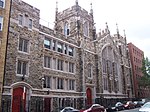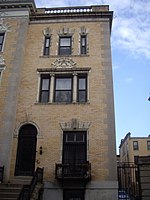Renaissance Ballroom & Casino
1920s in the United States1924 establishments in New York City1979 disestablishments in New York (state)African-American history in New York CityCultural history of New York City ... and 13 more
Defunct drinking establishments in ManhattanDefunct jazz clubs in New York CityDefunct nightclubs in the United StatesFormer buildings and structures in ManhattanFormer music venues in New York CityHarlemHistory of ManhattanJazz clubs in HarlemLindy HopMusic of New York CityMusic venues completed in 1924Nightclubs in ManhattanUse mdy dates from May 2023

The Renaissance Ballroom & Casino was an entertainment complex at 2341–2349 Adam Clayton Powell Jr. Boulevard (Seventh Avenue) in the Harlem neighborhood of Manhattan in New York City. When opened in 1921, it included a casino, ballroom, 900-seat theater, six retail stores, and a basketball arena. It spanned the entire eastern frontage of Adam Clayton Powell Jr. Boulevard between 137th and 138th Streets.
Excerpt from the Wikipedia article Renaissance Ballroom & Casino (License: CC BY-SA 3.0, Authors, Images).Renaissance Ballroom & Casino
Adam Clayton Powell Jr. Boulevard, New York Manhattan
Geographical coordinates (GPS) Address Nearby Places Show on map
Geographical coordinates (GPS)
| Latitude | Longitude |
|---|---|
| N 40.816944444444 ° | E -73.942083333333 ° |
Address
The Rennie
Adam Clayton Powell Jr. Boulevard 2351
10030 New York, Manhattan
New York, United States
Open on Google Maps










